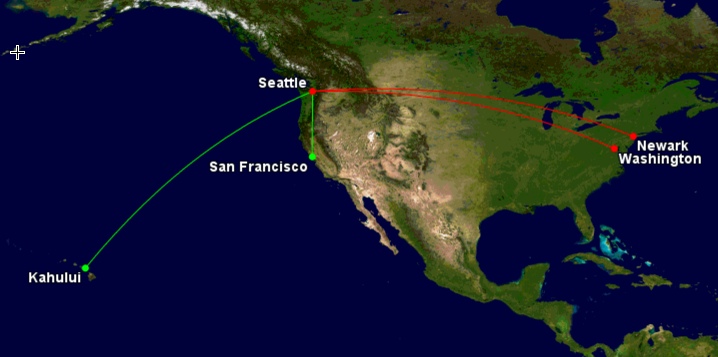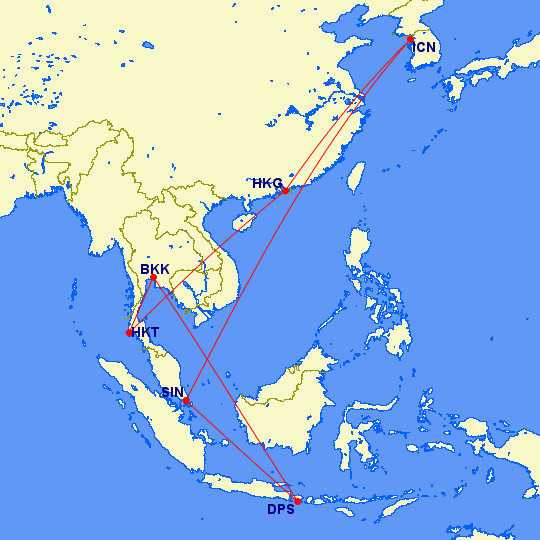One of the best arguments for using miles instead of cash to book your flights is that the routing rules are so much more flexible for award travel. Many loyalty programs offer the chance to add connections, stopovers, and open jaws that enable you to combine multiple trips into a single award.
Using miles is frustrating for many people due to limited availability, and these tricks can make that puzzle more complicated. Most airlines’ search tools are designed to find simple round-trip awards. It will be your responsibility to find award availability and piece together the complete itinerary, which might then require calling an agent to book. But you should fee comfortable attempting these strategies knowing they are well within most programs’ official rules.
Use Stopovers to Visit Cities along the Way
The easiest way to visit more cities on a single trip is to add free layovers and stopovers. Stopovers are connections that exceed four hours on domestic itineraries or 24 hours on international itineraries. Anything shorter than that is called a “layover.” You can have as many layovers as you want and even leave the airport for a brief tour of the connecting destination. Some cities, such as Zurich, Hong Kong and Singapore, offer convenient transit options to the city center. Stopovers are restricted, but you can spend several days or weeks before you continue onward.
Each airline has its own rules for stopovers. For example, Alaska Airlines permits a stopover on one-way awards — even for domestic travel — butUnited Airlines only allows a single stopover for international travel booked as part of a round-trip itinerary. But in general, all carriers require that travel be complete within 330 days of the original booking date, and visa limits may apply for any city you visit.

Award travel is typically priced according to the geographic regions of your origin and destination, and going out of your way to make extra stops doesn’t usually cost extra. Some carriers are particularly generous by, for example, allowing travel from North America to Asia via Europe. Combined with a stopover, that would allow someone in New York to add a free trip to Paris as part of an existing trip to Bangkok.
Use Open Jaws to Return to a Second Destination
Carriers tend to be more flexible in permitting open jaws compared to stopovers. This is simply where you “return” to a city other than the one you departed from. It gets its name from the gap created when you draw the itinerary on a map, and the jaw can usually be at either end of the trip. Assuming you still want to go back home, it’s a great way to explore a destination by land without returning to the exact city where you started (e.g., a tour of Europe).
Combining Rules for “Free” One-way Flights
Combining stopovers with an open jaw creates interesting opportunities. You are not necessarily required to use a free stopover at your destination. Some people instead choose their home airport — or depending on the award rules, another airport nearby. (A stopover in the same airport. They still get to fly from home from their destination, except that in the context of this itinerary “home” is really just a stop on a longer return journey.
Imagine creating an open jaw itinerary to Asia. San Francisco is the origin, and Shanghai is the destination, but you know you need to go to New York a month later. That return journey from Shanghai can be arranged to have a stopover in San Francisco, moving the actual “return city” to New York. After landing from Shanghai and going home, you can return to the airport and continue on to New York for the second journey at no extra cost.
You would still need to book a one-way flight back home from New York to San Francisco. But many domestic fares are priced on a one-way basis anyway. You’ve saved half the cost of your future New York visit thanks to planning ahead.
Nest Awards to Create Complex Itineraries
Stopovers and open jaws create opportunities to nest one award ticket within another. Cities that get infrequent service, like Siem Reap, may have limited or no service depending on the network of airline partners available. As a result, it might make more sense to book an additional ticket, either paying cash or as a second award.

Consider a round-trip from San Francisco to Bali via Bangkok using miles from United Airlines. You could be flying any of United’s partners and making additional connections as needed. Bali is the destination, but Bangkok can be added as your one free stopover. Now you’ve got a chance to visit two destinations for the price of one. You can add a third destination by booking a round-trip fare on discount carrier Bangkok Airways from Bangkok to Siem Reap. In this scenario you would fly to Bangkok, see the sights, and return to the airport. But you would fly to Siem Reap on a different ticket before flying back to Bangkok and continuing the original journey to Bali. (Note: the picture above represents a different, even more complex scenario that I actually booked last year.)
Routing Rules Affect How Miles Are Valued
These tricks don’t work on every airline. American Airlines recently changed its rules to prohibit stopovers even though their policies weren’t very generous to begin with. British Airways prices its awards separately for every individual segment, so it’s impossible to game the system.
For those programs that allow it, however, such rules can add exceptional value to your frequent flyer miles. It’s not as simple as saying that one program charges more miles than another for a given award. Sometimes a few extra miles are well worth the added flexibility in deciding where you stop along the way.
Note: This piece was written for and adapted by U.S. News and first appeared in the Travel Features section of usnews.com. Read the original article.
